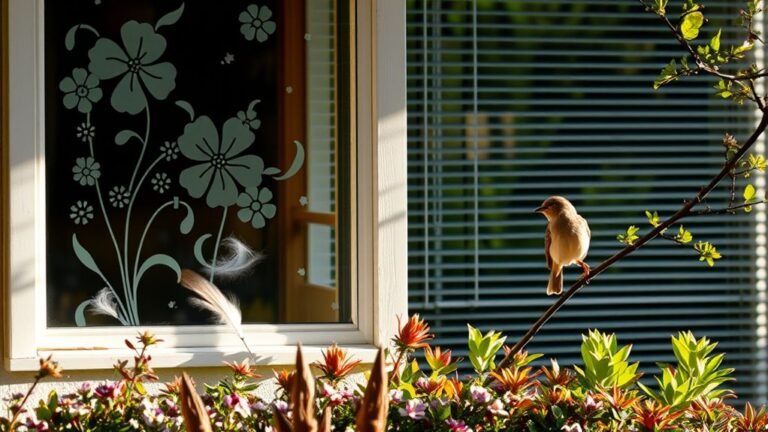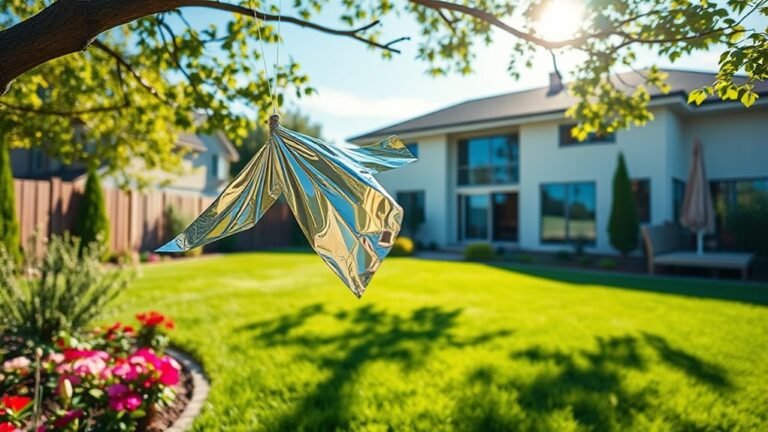How to Deter Birds from Your Vehicle: Effective Strategies To Kee Your Car Clean
Birds can be a significant nuisance for vehicle owners, causing damage and creating unsightly messes.
This comprehensive guide will explore various methods to deter birds from your vehicle, helping you maintain its appearance and value.
From understanding why birds target cars to implementing practical solutions, we’ll cover everything you need to know to keep your vehicle bird-free.

Key Takeaways
- Understand bird behavior: Learn why birds are attracted to vehicles and how to use this knowledge to your advantage.
- Choose parking spots wisely: Avoid areas with high bird activity to minimize the risk of droppings.
- Utilize visual deterrents: Reflective objects and predator decoys can effectively scare birds away.
- Implement sound-based solutions: Sonic and ultrasonic devices can create an unwelcoming environment for birds.
- Use physical barriers: Car covers and netting provide direct protection against bird droppings.
- Consider chemical repellents: Safe and effective options are available to deter birds without harming them.
- Try DIY solutions: Homemade deterrents can be cost-effective and fun to create.
- Maintain regular cleaning: A clean car is less likely to attract birds and easier to protect.
- Seek professional help: For persistent problems, expert assistance may be necessary.
- Follow legal and ethical guidelines: Ensure your bird control methods are humane and comply with local regulations.
Understanding the Bird Problem: Why Birds Target Cars
Birds often target cars for various reasons, making it a common issue for vehicle owners. One primary reason is that shiny surfaces of cars can attract birds, as they may mistake their reflections for potential mates or rivals.
Additionally, cars provide convenient perches for birds to rest, especially in urban areas where natural resting spots might be limited.
The warmth emitted by recently parked vehicles can also draw birds, particularly in cooler weather. Moreover, some bird species are territorial and may view a stationary car as an object to claim, leading to repeated visits and droppings.
Understanding these factors is crucial in developing effective strategies to deter birds from your vehicle.
Birds are also attracted to areas where food is abundant, so if you frequently park near trees with berries or in areas where people feed birds, your car is more likely to become a target.
The color of your vehicle can play a role too, with red cars often attracting more attention from certain bird species.
By recognizing these patterns and behaviors, you can better prepare and implement deterrent methods to protect your vehicle from unwanted avian visitors.
The Importance of Protecting Your Vehicle from Bird Droppings

Protecting your vehicle from bird droppings is crucial for maintaining its appearance and value.
Bird excrement is not just unsightly; it can cause significant damage to your car’s paint and finish. The acidic nature of bird droppings can etch into the paint, potentially leading to permanent marks if not removed promptly.
This damage can be particularly severe in hot weather, as the heat accelerates the chemical reaction between the droppings and the paint.
Over time, repeated incidents can lead to discoloration, fading, and even rust if the paint becomes compromised.
Beyond the cosmetic issues, bird droppings can also affect your car’s resale value. A vehicle with visible paint damage or a history of frequent bird-related issues may be less attractive to potential buyers.
Additionally, constantly cleaning bird droppings can be time-consuming and may require special products to avoid further damage to your car’s finish.
By implementing effective deterrent strategies, you not only preserve your car’s appearance but also save time and money on cleaning and potential repairs.
Protecting your vehicle from birds is an essential aspect of car maintenance that should not be overlooked.
Choosing the Right Parking Spot: Location Matters
Selecting the right parking spot is a crucial first step in deterring birds from your vehicle. One very easy method to increase your overall chances of avoiding avian messes is to park away from places where birds hang out.
Avoid parking under trees, near building ledges, or close to power lines, as these are common perching spots for birds.
Instead, opt for open areas or covered parking structures whenever possible. If you have access to a garage, this is the most efficient method to prevent bird droppings from landing on your vehicle.
When parking in public spaces, be observant of your surroundings. Look for signs of bird activity, such as nests or frequent flyovers.
If you notice a particular area tends to attract birds, try to find alternative parking spots. Additionally, avoid parking at the edges of buildings, as birds often perch on these elevated surfaces.
By being mindful of your parking choices, you can significantly reduce the likelihood of bird-related issues with your vehicle.
Remember, a little extra effort in selecting your parking spot can go a long way in keeping your car clean and bird-free.
Visual Deterrents: Scaring Birds Away

Visual deterrents can be highly effective in keeping birds away from your vehicle. One popular method is using reflective objects that create moving light patterns, which birds find disorienting and unsettling.
You can place CDs or other reflective materials around your car to achieve this effect.
Some car owners have found success with holographic tape or pinwheels, which create movement and reflections that birds tend to avoid.
Another effective visual deterrent is the use of predator decoys. Placing a fake owl or hawk near your parking area can scare away smaller birds.
Some car owners have even reported success with using rubber snakes placed on their vehicles. These decoys work by triggering the birds’ natural fear of predators.
However, it’s important to move these decoys periodically, as birds may become accustomed to stationary objects over time.
For a more high-tech solution, consider using moving deterrents like the Bird Spider 360 or Repeller 360. These devices use wind-powered movement and reflective surfaces to create an environment that birds find unwelcoming.
While these options may require a bit more investment, they can be particularly effective for persistent bird problems.
Sound-Based Solutions: Auditory Deterrents for Birds
Auditory deterrents can be a powerful tool in keeping birds away from your vehicle. One effective option is the use of sonic bird scarers, which emit predator calls or distress signals that birds associate with danger.
The Bird Chase Super Sonic is an example of such a device, playing prerecorded distress calls at predetermined intervals.
These sounds communicate to birds that the area is unsafe, encouraging them to seek alternative locations.
Another sound-based solution is the use of ultrasonic devices. These emit high-frequency sounds that are unpleasant to birds but generally inaudible to humans.
While their effectiveness can vary depending on the bird species, many car owners find them helpful in deterring persistent avian visitors.
Some of these devices are solar-powered or battery-operated, making them convenient for use in parking areas.
It’s important to note that while sound-based deterrents can be effective, they should be used responsibly.
Avoid using them constantly, as birds may eventually become accustomed to the sounds. Instead, consider using them intermittently or in combination with other deterrent methods for maximum effectiveness.
Additionally, be mindful of your neighbors when using auditory deterrents, especially in residential areas.
Physical Barriers: Covers and Netting
Physical barriers provide a direct and effective method to protect your vehicle from bird droppings.
Car covers are an excellent option, especially for long-term parking or when your car is not in frequent use. Choose a cover made of durable materials like vinyl or nylon, preferably with a UV-protective coating.
This not only prevents bird droppings from reaching your car’s surface but also protects against other environmental factors like sun damage and dust.
For more targeted protection, consider using mirror covers or socks to protect your side mirrors.
This is particularly useful if you’ve noticed birds are specifically targeting your mirrors, either for perching or due to their reflective nature.
Some car owners have found success with simply folding in their side mirrors when parking, if their vehicle has this feature.
In situations where overhead protection is needed, bird netting can be an effective solution. While more commonly used in larger parking structures or garages, smaller sections of netting can be adapted for individual use.
When properly installed, netting creates a physical barrier that prevents birds from accessing your vehicle while still allowing for easy removal when you need to use your car.
Chemical Repellents: Safe and Effective Options
Chemical repellents can be an effective way to deter birds from your vehicle, provided they are used safely and responsibly.
One popular option is the use of methyl anthranilate (MA), a non-toxic substance that irritates birds’ senses without harming them.
Products containing MA, such as Avian Block and Avian Control, can be applied to areas around your parking spot to create an unpleasant environment for birds.
Another type of chemical deterrent is bird gel, which creates a sticky surface that birds find uncomfortable to land on.
However, it’s important to use these products cautiously and as directed, as some gels can be harmful if birds become stuck in them. Always opt for humane solutions that deter birds without causing them harm.
When using any chemical repellent, it’s crucial to ensure it won’t damage your vehicle’s paint or finish. Test the product on a small, inconspicuous area first.
Additionally, be mindful of environmental impacts and local regulations regarding the use of chemical deterrents.
Some areas may have restrictions on certain types of bird repellents, so it’s always best to check local guidelines before application.
DIY Solutions: Homemade Bird Deterrents
Creating your own bird deterrents can be an effective and budget-friendly way to protect your vehicle.
One simple DIY solution is to create reflective hangers using old CDs or DVDs. Suspend these near your parking area; the moving reflections will deter birds.
Another easy option is to use aluminum foil strips or reflective tape. These can be tied to nearby structures or even on your car’s antenna when parked.
For a more natural approach, consider using strong-smelling herbs or spices. Birds are known to dislike the scent of peppermint, citrus, and chili pepper. You can create sachets filled with these aromatics and place them near your parking spot.
Some car owners have found success with hanging old keys or small bells near their vehicles. The unexpected movement and sound can startle birds and keep them away.
Remember, the key to effective DIY deterrents is regular change and movement. Birds can become accustomed to stationary objects, so rotate your homemade deterrents or change their positions frequently for best results.
While these solutions may require a bit more effort, they can be a fun and cost-effective way to keep your car bird-free.
Regular Cleaning and Maintenance: Minimizing Attraction
Regular cleaning and maintenance of your vehicle play a crucial role in deterring birds. A clean, waxed surface is less likely to attract birds compared to a dirty one. Bird droppings often contain seeds, which can attract more birds if left on your car.
By promptly cleaning any droppings, you reduce the likelihood of repeat visits. Use a specialized car cleaner designed to safely remove bird droppings without damaging your paint.
Maintaining your car’s appearance also involves addressing any reflective surfaces that might attract birds.
If you notice birds are particularly drawn to your side mirrors or chrome accents, consider covering these areas when parked. Some car owners use old socks or small covers specifically designed for side mirrors.
Additionally, regular waxing of your car not only keeps it looking great but also makes it easier to clean off any droppings quickly.
A well-maintained, clean car is less likely to become a habitual target for birds. Remember, consistency is key in this approach.
Make cleaning and maintenance a regular part of your car care routine to effectively minimize bird attraction.
Professional Solutions: When to Seek Expert Help
While many bird deterrent methods can be implemented on your own, there are situations where professional help might be necessary.
If you’re dealing with a persistent or large-scale bird problem, especially in commercial parking areas or residential complexes, professional bird control services can offer more comprehensive solutions.
These experts can assess the specific bird species causing issues and recommend tailored strategies.
Professional services often have access to more advanced deterrent systems, such as sophisticated sonic devices or large-scale netting installations.
They can also provide and install professional-grade visual deterrents like the Bird Spider 360 or Repeller 360, which might be more effective than DIY solutions for severe problems.
Additionally, if you’ve experienced significant damage to your vehicle’s paint or finish due to bird droppings, seeking help from a professional auto detailer might be necessary.
They can assess the damage and perform specialized treatments to restore your car’s appearance.
Remember, while professional services might be more costly upfront, they can save you time and money in the long run by effectively addressing persistent bird problems.
Legal and Ethical Considerations: Humane Bird Control
When implementing bird deterrent methods, it’s crucial to consider both legal and ethical aspects.
Many bird species are protected under laws such as the Migratory Bird Treaty Act of 1918, making it illegal to harm or kill them. Always opt for humane deterrent methods that don’t cause physical harm to birds.
Avoid using sticky gels or traps that could injure birds or other wildlife.
Be mindful of local regulations regarding bird control methods. Some areas may have restrictions on certain types of deterrents, particularly those that produce noise or use chemicals.
If you’re dealing with a bird problem in a shared or public space, consult with property management or local authorities before implementing any deterrent strategies.
Consider the environmental impact of your chosen methods. Opt for eco-friendly solutions whenever possible.
For instance, physical barriers and visual deterrents are generally more environmentally friendly than chemical repellents.
Remember, the goal is to deter birds from your vehicle, not to harm them or disrupt local ecosystems. By choosing humane and legal methods, you can protect your car while being a responsible member of your community.
FAQs
How often should I clean bird droppings off my car?
It’s best to clean bird droppings off your car as soon as possible. The acidic nature of the droppings can damage your car’s paint if left for too long, especially in hot weather. If immediate cleaning isn’t possible, try to remove the droppings within 24 hours.
Are there any colors that birds are less attracted to?
While birds can be attracted to bright colors, especially red, there’s no definitive color that repels all birds. However, darker, matte colors tend to be less reflective and may attract less attention from birds compared to bright or shiny colors.
Can I use a car cover in all weather conditions?
Most car covers are designed to be weather-resistant, but it’s important to choose one appropriate for your climate. In extreme weather conditions, ensure your cover is securely fastened to prevent wind damage. Always use a cover that’s clean and dry to avoid trapping moisture against your car’s surface.
How effective are ultrasonic bird repellers?
Ultrasonic bird repellers can be effective, but their success varies depending on the bird species and the specific environment. They tend to work best when used in combination with other deterrent methods and may require periodic repositioning to prevent birds from becoming accustomed to them.
Is it safe to use bird spikes on my car?
Bird spikes are not recommended for use directly on vehicles. They are designed for stationary surfaces like building ledges or signs. For cars, opt for removable deterrents like covers, visual scares, or sound-based solutions that won’t potentially damage your vehicle’s surface.
How can I protect my car if I don’t have access to a garage?
If you don’t have garage access, consider using a high-quality car cover. Alternatively, try parking away from trees and buildings, use portable visual deterrents like reflective objects, or invest in a foldable carport for additional protection.
Are there any plants that naturally repel birds?
While no plant completely repels all birds, some plants like lavender, marigolds, and rosemary are known to be less attractive to birds. However, using plants as a deterrent is more effective for garden areas rather than directly protecting a vehicle.
How do I remove stubborn bird droppings without damaging my car’s paint?
To remove stubborn bird droppings, wet the area thoroughly with water or a car-safe cleaner. Let it soak for a few minutes to soften the droppings. Then, use a soft, damp microfiber cloth to gently wipe away the residue. Avoid scrubbing harshly, as this can damage the paint.
Can bird droppings affect my car’s resale value?
Yes, repeated exposure to bird droppings can potentially affect your car’s resale value. If left uncleaned, they can cause permanent damage to the paint, which may be visible even after cleaning. Regular cleaning and protection can help maintain your car’s appearance and value.
Is it legal to use decoy predators like fake owls to scare birds?
Using decoy predators like fake owls is generally legal and considered a humane method of bird control. However, it’s always best to check local regulations, especially if you’re using them in public spaces or shared residential areas.

Hello, I’m Amelia White, the founder of birdsfanatic.com. As a lifelong bird enthusiast and spiritual seeker, I’ve always been fascinated by the mystical connections between birds and the human experience. On this site, I share my knowledge and insights into the symbolic meanings and spiritual significance of various bird species, exploring their roles in mythology, folklore, and cultural traditions. Join me on this journey into the world of birds, where we’ll discover the hidden wisdom and guidance that these magnificent creatures have to offer.







